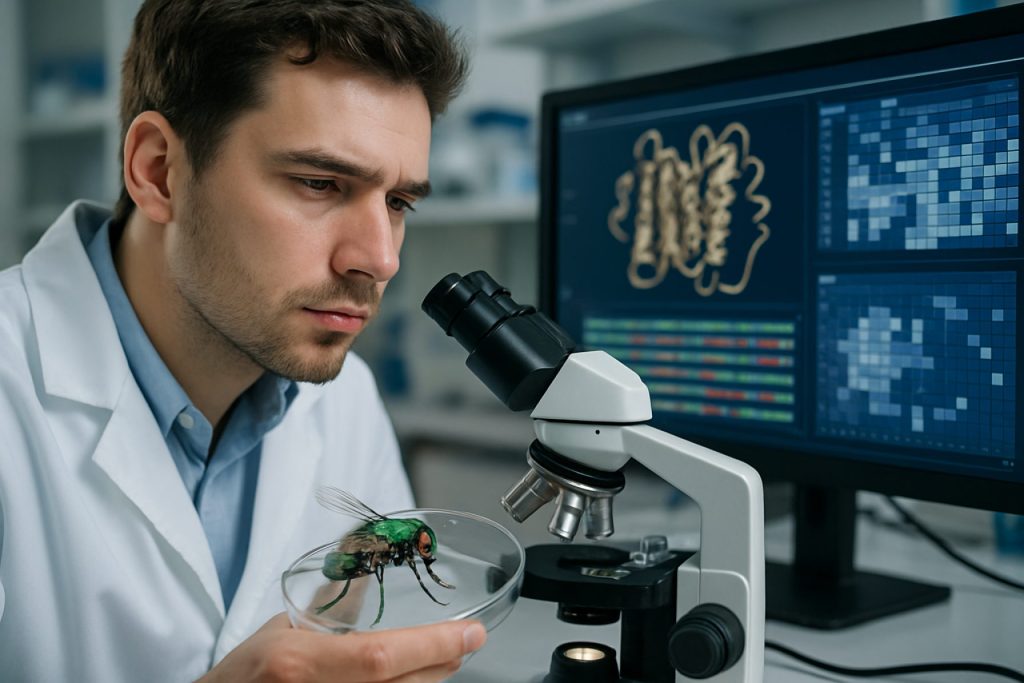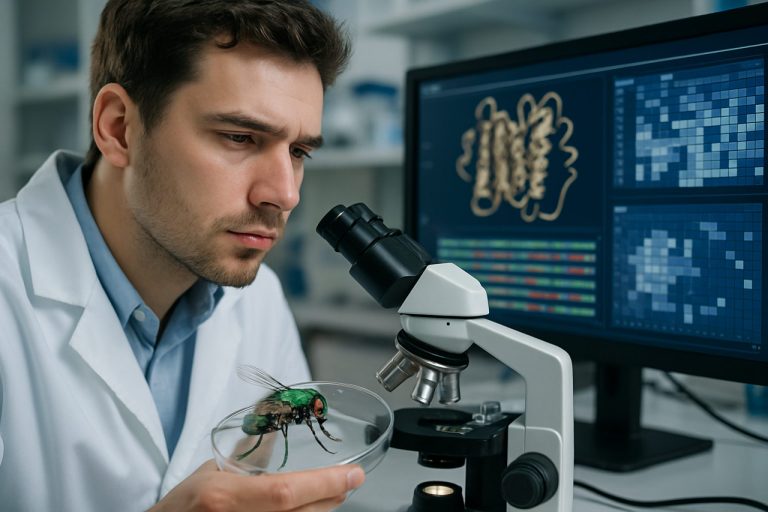
Decoding the Molecular Language of Insect Smell: How Bioinformatics is Revolutionizing Our Understanding of Olfactory Receptors. Explore the Latest Advances, Applications, and Future Directions in Sensory Genomics. (2025)
- Introduction: The Significance of Insect Olfactory Receptors
- Molecular Architecture of Insect Olfactory Receptors
- Bioinformatics Tools and Databases for Olfactory Receptor Analysis
- Comparative Genomics: Evolutionary Insights Across Insect Species
- Functional Annotation and Structure Prediction Techniques
- Big Data and Machine Learning in Olfactory Receptor Research
- Applications in Pest Control and Agricultural Biotechnology
- Emerging Technologies: CRISPR, Single-Cell Sequencing, and Beyond
- Market and Public Interest Forecast: Growth and Societal Impact (Estimated 20–30% Increase in Research and Application by 2030)
- Future Outlook: Challenges, Opportunities, and Ethical Considerations
- Sources & References
Introduction: The Significance of Insect Olfactory Receptors
Insect olfactory receptors (ORs) are pivotal molecular components that enable insects to detect and discriminate a vast array of chemical cues in their environment. These receptors, primarily located on the antennae, are central to behaviors such as foraging, mating, and oviposition, making them critical targets for both fundamental research and applied sciences. The study of insect ORs has gained significant momentum in recent years, driven by advances in genomics, transcriptomics, and computational biology. As of 2025, the integration of bioinformatics approaches has revolutionized our understanding of the diversity, evolution, and function of these receptors.
The significance of insect ORs extends beyond basic biology. In agriculture, for example, understanding the molecular basis of olfaction in pest species can inform the development of novel, environmentally friendly pest management strategies. By targeting specific ORs, it is possible to disrupt host-seeking or mating behaviors, reducing reliance on chemical pesticides. Similarly, in public health, elucidating the olfactory mechanisms of disease vectors such as mosquitoes can aid in controlling the spread of vector-borne diseases. The World Health Organization has highlighted the importance of innovative vector control methods, including those based on behavioral manipulation, underscoring the relevance of olfactory receptor research.
Bioinformatics has become indispensable in this field, enabling the annotation and comparative analysis of OR gene families across diverse insect taxa. High-throughput sequencing projects, such as those coordinated by the National Center for Biotechnology Information (NCBI), have generated extensive genomic and transcriptomic datasets, facilitating the identification of OR genes even in non-model species. Computational tools allow researchers to predict receptor structure, ligand-binding sites, and evolutionary relationships, accelerating the functional characterization of these proteins.
Looking ahead, the next few years are expected to see further integration of multi-omics data, machine learning, and structural bioinformatics to unravel the complexities of insect olfaction. Collaborative initiatives, such as those supported by the European Molecular Biology Laboratory (EMBL), are fostering data sharing and methodological innovation. As the field advances, the bioinformatics of insect olfactory receptors will continue to provide critical insights with broad implications for ecology, agriculture, and public health.
Molecular Architecture of Insect Olfactory Receptors
The molecular architecture of insect olfactory receptors (ORs) has become a focal point in bioinformatics, especially as high-throughput sequencing and computational modeling techniques have advanced rapidly into 2025. Insect ORs, which are primarily responsible for detecting volatile chemical cues in the environment, are structurally distinct from vertebrate olfactory receptors. They typically function as heteromeric complexes, composed of a variable odorant-binding subunit (OrX) and a highly conserved co-receptor (Orco). This unique configuration has been elucidated through a combination of genomics, transcriptomics, and structural bioinformatics approaches.
Recent years have seen the expansion of insect genome databases, with annotated OR gene families now available for hundreds of species, including key agricultural pests and disease vectors. The National Center for Biotechnology Information (NCBI) and the European Bioinformatics Institute (EMBL-EBI) have played central roles in curating these datasets, enabling comparative analyses that reveal both conserved motifs and lineage-specific expansions within OR gene families. These resources have facilitated the identification of orthologous and paralogous relationships, as well as the prediction of ligand-binding domains using machine learning algorithms.
Structural modeling has also progressed, with the application of deep learning-based tools such as AlphaFold, developed by DeepMind, providing high-confidence predictions of OR and Orco 3D structures. These models have been instrumental in hypothesizing the arrangement of transmembrane helices and the putative ligand-binding pockets, which are challenging to resolve experimentally due to the membrane-bound nature of these proteins. The integration of cryo-electron microscopy (cryo-EM) data, where available, has further refined these models, offering insights into the dynamic conformational changes associated with odorant binding and signal transduction.
Looking ahead, the next few years are expected to bring more comprehensive multi-omics datasets, including single-cell transcriptomics and spatial proteomics, which will enhance the resolution of OR expression patterns across different insect tissues and developmental stages. The continued development of open-access bioinformatics platforms by organizations such as EMBL-EBI and NCBI will be crucial for integrating these diverse data types. These advances are anticipated to accelerate the functional annotation of orphan ORs and to inform the rational design of novel insect control strategies, leveraging the molecular specificity of olfactory signaling pathways.
Bioinformatics Tools and Databases for Olfactory Receptor Analysis
The bioinformatics landscape for insect olfactory receptor (OR) analysis is rapidly evolving, driven by advances in sequencing technologies, computational biology, and the growing need to understand chemosensory systems for applications in agriculture, vector control, and synthetic biology. As of 2025, several specialized databases and tools have become central to the field, enabling researchers to annotate, compare, and functionally characterize the diverse and rapidly evolving OR gene families across insect taxa.
A cornerstone resource is National Center for Biotechnology Information (NCBI), which hosts genomic and transcriptomic datasets for hundreds of insect species. NCBI’s GenBank and RefSeq repositories provide foundational sequence data, while the BLAST suite remains essential for homology searches and gene identification. Complementing these, the European Bioinformatics Institute (EMBL-EBI) offers Ensembl Metazoa, a platform for comparative genomics and gene annotation across invertebrates, including curated olfactory receptor gene models.
For more targeted analysis, the VectorBase platform, maintained by the Bioinformatics Resource Center, is pivotal for researchers working on disease vectors such as mosquitoes. VectorBase integrates genomic, transcriptomic, and functional data, supporting the annotation and comparative analysis of ORs in medically relevant insects. Similarly, the InsectBase database (hosted by the China National GeneBank) aggregates insect genomic resources, including curated olfactory receptor gene families, expression profiles, and orthology relationships.
Recent years have seen the emergence of specialized tools for OR gene prediction and classification. Machine learning-based pipelines, such as those leveraging hidden Markov models (HMMs), are increasingly used to identify divergent OR genes from raw genomic data. Tools like OrthoFinder and InterProScan, available through EMBL-EBI, facilitate orthology inference and domain annotation, respectively, supporting large-scale comparative studies. Additionally, the UniProt Knowledgebase provides curated protein sequences and functional annotations, including ligand-binding predictions for insect ORs.
Looking ahead, the integration of multi-omics datasets—combining genomics, transcriptomics, and proteomics—will be a major trend, enabling more accurate functional annotation and evolutionary analysis of ORs. The adoption of FAIR (Findable, Accessible, Interoperable, Reusable) data principles by major bioinformatics organizations is expected to enhance data sharing and interoperability. Furthermore, the development of community-driven, open-access repositories dedicated specifically to insect chemosensory genes is anticipated, fostering collaboration and accelerating discovery in the field.
Comparative Genomics: Evolutionary Insights Across Insect Species
Comparative genomics has become a cornerstone in unraveling the evolutionary dynamics of insect olfactory receptors (ORs), leveraging bioinformatics to analyze vast genomic datasets across diverse species. As of 2025, the integration of high-throughput sequencing and advanced computational tools has enabled researchers to systematically compare OR gene families, revealing patterns of expansion, contraction, and diversification that underpin the remarkable adaptability of insect olfaction.
Recent years have seen a surge in the availability of high-quality insect genomes, driven by international initiatives such as the European Bioinformatics Institute and the National Center for Biotechnology Information. These resources have facilitated large-scale comparative analyses, allowing scientists to trace the evolutionary trajectories of OR genes across phylogenetically distant taxa, including Diptera (flies and mosquitoes), Lepidoptera (moths and butterflies), and Hymenoptera (bees and ants).
Bioinformatic pipelines now routinely employ orthology inference, gene family clustering, and synteny analysis to identify conserved and lineage-specific ORs. For example, studies have demonstrated that while some OR subfamilies are highly conserved—suggesting essential roles in detecting ecologically relevant odors—others exhibit rapid gene turnover, reflecting adaptation to species-specific ecological niches. The Ensembl platform, maintained by EMBL-EBI, has been instrumental in providing annotated gene models and comparative genomics tools that support these analyses.
A notable trend in 2025 is the application of machine learning to predict OR function based on sequence features and evolutionary context. These approaches are being refined using curated datasets from model organisms such as Drosophila melanogaster and Anopheles gambiae, whose OR repertoires have been extensively characterized. The UniProt database continues to serve as a central repository for protein sequences and functional annotations, supporting cross-species comparisons and hypothesis generation.
Looking ahead, the next few years are expected to bring further insights as more non-model insect genomes are sequenced and integrated into comparative frameworks. The ongoing efforts of the Global Insect Genome Alliance aim to sequence thousands of insect species, which will vastly expand the phylogenetic breadth of available data. This will enable finer-scale resolution of OR gene evolution, including the identification of convergent adaptations and the genetic basis of olfactory-driven behaviors. Such advances will not only deepen our understanding of insect sensory biology but also inform the development of novel strategies for pest management and pollinator conservation.
Functional Annotation and Structure Prediction Techniques
The functional annotation and structure prediction of insect olfactory receptors (ORs) have become central to bioinformatics-driven research, especially as high-throughput sequencing continues to expand the catalog of candidate OR genes across diverse insect species. In 2025, the field is characterized by the integration of advanced computational tools, machine learning algorithms, and expanding public databases, which together are accelerating the pace and accuracy of OR characterization.
Functional annotation of insect ORs typically begins with the identification of gene sequences from genomic or transcriptomic data. Automated pipelines, such as those provided by National Center for Biotechnology Information (NCBI) and European Bioinformatics Institute (EMBL-EBI), are widely used for sequence alignment, domain prediction, and gene ontology assignment. These resources leverage curated protein family databases, including Pfam and InterPro, to assign putative functions based on conserved motifs and sequence homology. Recent advances have seen the adoption of deep learning models for more nuanced annotation, particularly in distinguishing closely related OR subfamilies and predicting ligand-binding specificity.
Structure prediction has undergone a paradigm shift with the advent of artificial intelligence-based tools. The release and ongoing refinement of AlphaFold by DeepMind have enabled researchers to generate high-confidence three-dimensional models of insect ORs, even in the absence of experimental structures. These models are increasingly being deposited in public repositories such as the RCSB Protein Data Bank (RCSB PDB), facilitating comparative studies and hypothesis-driven mutagenesis. In 2025, collaborative efforts between computational biologists and experimentalists are focusing on validating these predictions through cryo-electron microscopy and site-directed mutagenesis, with the aim of elucidating the molecular basis of odorant recognition and signal transduction.
Looking ahead, the next few years are expected to see further integration of multi-omics data—combining genomics, transcriptomics, and proteomics—to refine functional annotation and uncover regulatory networks governing OR expression. The development of community-driven platforms, such as those coordinated by the UniProt Consortium, is anticipated to standardize annotation protocols and improve data interoperability. Additionally, the application of generative AI models for de novo structure prediction and ligand docking is poised to accelerate the discovery of novel OR functions and their potential applications in pest management and synthetic biology.
Big Data and Machine Learning in Olfactory Receptor Research
The integration of big data analytics and machine learning (ML) is rapidly transforming the bioinformatics landscape of insect olfactory receptor (OR) research. As of 2025, the field is experiencing a surge in high-throughput sequencing and functional genomics data, driven by advances in next-generation sequencing and single-cell transcriptomics. These technologies have enabled the comprehensive cataloging of OR gene families across diverse insect taxa, generating vast datasets that require sophisticated computational approaches for analysis and interpretation.
Machine learning algorithms, particularly deep learning models, are now routinely applied to predict OR-ligand interactions, classify receptor subtypes, and infer evolutionary relationships. For example, convolutional neural networks (CNNs) and graph neural networks (GNNs) are being used to model the three-dimensional structures of OR proteins and to simulate their binding affinities with volatile organic compounds. These approaches are supported by open-access databases and computational resources maintained by major bioinformatics organizations such as the European Bioinformatics Institute and the National Center for Biotechnology Information, which provide curated genomic and proteomic datasets essential for training and validating ML models.
A key development in 2025 is the emergence of integrative platforms that combine multi-omics data—genomics, transcriptomics, proteomics, and metabolomics—to construct comprehensive models of olfactory signaling pathways. These platforms leverage cloud computing and distributed data storage, enabling researchers to analyze petabyte-scale datasets collaboratively and efficiently. The ELIXIR infrastructure, a pan-European initiative, exemplifies this trend by facilitating data sharing and interoperability among research institutions focused on life sciences.
Looking ahead, the next few years are expected to see further refinement of ML algorithms for OR research, with a focus on explainable AI to enhance biological interpretability. There is also growing interest in federated learning approaches, which allow for the decentralized analysis of sensitive or proprietary datasets without compromising data privacy. These advances are anticipated to accelerate the discovery of novel ORs, elucidate their functional roles in insect behavior, and inform the design of targeted pest management strategies.
Overall, the convergence of big data and machine learning is poised to unlock new insights into the molecular mechanisms of insect olfaction, with broad implications for agriculture, public health, and environmental monitoring. Continued investment in computational infrastructure and international collaboration will be critical to realizing the full potential of these technologies in the bioinformatics of insect olfactory receptors.
Applications in Pest Control and Agricultural Biotechnology
The application of bioinformatics to the study of insect olfactory receptors (ORs) is rapidly transforming pest control and agricultural biotechnology as of 2025. Insect ORs are central to behaviors such as host-seeking, mating, and oviposition, making them prime targets for innovative pest management strategies. Recent advances in high-throughput sequencing and computational modeling have enabled the identification and functional annotation of OR gene families across a wide range of pest species, including major agricultural threats like Helicoverpa armigera and Spodoptera frugiperda.
Bioinformatics pipelines now routinely integrate genomic, transcriptomic, and proteomic data to predict OR structure and ligand specificity. This has led to the discovery of species-specific ORs that can be targeted to disrupt pest behavior without affecting non-target organisms. For example, machine learning algorithms are being used to model the binding affinities between ORs and semiochemicals, accelerating the design of novel attractants and repellents. These computational approaches are complemented by CRISPR-based functional validation, allowing for rapid in vivo testing of candidate ORs and their ligands.
In 2025, several international initiatives are leveraging these bioinformatics tools to develop next-generation pest control solutions. The Food and Agriculture Organization of the United Nations (FAO) is supporting collaborative projects aimed at reducing pesticide reliance by exploiting insect olfactory pathways. Similarly, the Centre for Agriculture and Bioscience International (CABI) is facilitating the translation of OR bioinformatics into field-ready biocontrol agents, such as pheromone-based traps and push-pull systems.
The integration of OR bioinformatics into agricultural biotechnology is also enabling the development of genetically engineered crops that emit specific volatile organic compounds to repel pests or attract their natural enemies. This approach, underpinned by detailed OR-ligand interaction maps, is being explored in staple crops like maize and rice, with field trials underway in several regions. Regulatory agencies, including the United States Environmental Protection Agency (EPA), are actively evaluating the environmental safety and efficacy of these bioengineered solutions.
Looking ahead, the next few years are expected to see further refinement of OR-targeted pest control strategies, driven by advances in artificial intelligence, multi-omics integration, and open-access data sharing. The continued collaboration between research institutions, international organizations, and regulatory bodies will be crucial for translating bioinformatics discoveries into sustainable agricultural practices that address both productivity and environmental concerns.
Emerging Technologies: CRISPR, Single-Cell Sequencing, and Beyond
The bioinformatics landscape for insect olfactory receptors (ORs) is rapidly evolving, driven by the integration of cutting-edge technologies such as CRISPR-based genome editing, single-cell sequencing, and advanced computational modeling. As of 2025, these innovations are enabling unprecedented insights into the structure, function, and evolution of insect ORs, with significant implications for agriculture, vector control, and synthetic biology.
CRISPR-Cas systems have become indispensable for functional genomics in insects, allowing precise manipulation of OR genes to elucidate their roles in odor detection and behavior. Recent studies leverage CRISPR to generate targeted knockouts and knock-ins in model insects like Drosophila melanogaster and disease vectors such as Anopheles gambiae. These manipulations, when combined with high-throughput behavioral assays and transcriptomic profiling, are generating large datasets that require sophisticated bioinformatics pipelines for analysis and interpretation. The National Institutes of Health and Centre National de la Recherche Scientifique are among the organizations supporting these integrative approaches, fostering collaborations between molecular biologists, computational scientists, and entomologists.
Single-cell RNA sequencing (scRNA-seq) is another transformative technology, now routinely applied to insect olfactory tissues. This approach enables the resolution of gene expression at the level of individual olfactory sensory neurons, revealing the diversity and specificity of OR gene expression patterns. In 2025, several consortia are building comprehensive single-cell atlases of insect antennae, providing reference datasets for comparative genomics and evolutionary studies. The European Bioinformatics Institute and European Molecular Biology Laboratory are key players in curating and disseminating these datasets, ensuring open access and interoperability with global bioinformatics resources.
Beyond CRISPR and single-cell sequencing, machine learning and artificial intelligence are increasingly applied to predict OR-ligand interactions, model receptor structures, and mine large-scale genomic data. These computational advances are accelerating the annotation of OR gene families across diverse insect species, including agricultural pests and pollinators. The integration of multi-omics data—genomics, transcriptomics, proteomics—into unified analytical frameworks is a major trend, supported by initiatives from organizations such as the National Science Foundation.
Looking ahead, the next few years are expected to see further convergence of experimental and computational methods, with the development of more accurate in silico models and the expansion of public databases dedicated to insect chemosensation. These advances will not only deepen our understanding of insect olfaction but also inform the design of novel pest management strategies and biosensors.
Market and Public Interest Forecast: Growth and Societal Impact (Estimated 20–30% Increase in Research and Application by 2030)
The bioinformatics of insect olfactory receptors (ORs) is poised for significant growth and societal impact through 2030, with research and application activity projected to increase by an estimated 20–30%. This surge is driven by advances in computational biology, the expanding availability of insect genomic data, and the urgent need for sustainable solutions in agriculture, public health, and environmental monitoring.
In 2025, the field is characterized by the integration of high-throughput sequencing, machine learning, and structural modeling to decode the vast diversity of insect ORs. Major initiatives, such as the National Institutes of Health-funded projects and the European Bioinformatics Institute’s resources, are enabling researchers to annotate and compare OR gene families across hundreds of insect species. These efforts are supported by global consortia like the International Genome Sample Resource, which provides open-access genomic datasets critical for comparative analyses.
Market interest is intensifying as bioinformatics-driven insights into insect olfaction translate into practical applications. In agriculture, companies and research organizations are leveraging OR data to design targeted pest control strategies that disrupt insect host-seeking and mating behaviors, reducing reliance on broad-spectrum chemical pesticides. For example, the development of biosensors and attractants based on OR-ligand interactions is being accelerated by collaborations between academic groups and industry leaders in biotechnology and crop protection.
Public health sectors are also investing in OR bioinformatics to combat vector-borne diseases. By identifying and manipulating the olfactory pathways of disease-carrying insects such as mosquitoes, researchers aim to develop novel repellents and traps. Organizations like the World Health Organization are supporting these efforts as part of integrated vector management programs, recognizing the potential for bioinformatics to inform next-generation interventions.
Looking ahead, the societal impact of this field is expected to broaden. Enhanced understanding of insect olfaction will not only improve food security and disease control but also contribute to biodiversity conservation by informing pollinator management and invasive species monitoring. The anticipated 20–30% growth in research and application by 2030 reflects both the expanding technological capabilities and the increasing recognition of insect OR bioinformatics as a cornerstone of sustainable innovation.
Future Outlook: Challenges, Opportunities, and Ethical Considerations
The future of bioinformatics applied to insect olfactory receptors (ORs) is poised for significant advances, driven by rapid developments in genomics, machine learning, and high-throughput functional assays. As of 2025, the integration of multi-omics datasets—encompassing genomics, transcriptomics, and proteomics—has enabled researchers to map the diversity and evolution of OR gene families across a wide range of insect species. This is particularly relevant for agricultural pests and disease vectors, where understanding olfactory mechanisms can inform novel control strategies.
One of the main challenges remains the functional annotation of the vast number of OR genes identified in insect genomes. While sequencing costs have plummeted and reference genomes for key species are now available, the assignment of ligand specificity to individual ORs lags behind. Computational approaches, including deep learning models trained on known receptor-ligand interactions, are being developed to predict binding affinities and guide experimental validation. However, the accuracy of these models is limited by the scarcity of high-quality, experimentally validated datasets. Collaborative efforts, such as those coordinated by the European Bioinformatics Institute and the National Center for Biotechnology Information, are crucial for curating and standardizing olfactory receptor data.
Opportunities abound in leveraging bioinformatics to design targeted interventions. For example, the identification of species-specific ORs could enable the development of highly selective attractants or repellents, reducing reliance on broad-spectrum insecticides and mitigating environmental impact. Synthetic biology approaches, informed by bioinformatics, may allow the engineering of biosensors or the modification of insect behavior for crop protection and disease control. The Food and Agriculture Organization of the United Nations has highlighted the potential of such precision strategies in sustainable agriculture.
Ethical considerations are increasingly prominent as bioinformatics enables more precise manipulation of insect olfaction. The release of genetically modified insects or the deployment of synthetic attractants in the environment raises questions about ecological balance, non-target effects, and long-term consequences. Transparent risk assessment frameworks and public engagement, as advocated by organizations like the World Health Organization, will be essential to ensure responsible innovation.
Looking ahead, the next few years will likely see the expansion of open-access databases, improved computational tools, and greater interdisciplinary collaboration. These advances will accelerate the translation of bioinformatics insights into practical applications, while ongoing dialogue among scientists, policymakers, and the public will shape the ethical landscape of this rapidly evolving field.
Sources & References
- World Health Organization
- National Center for Biotechnology Information
- European Molecular Biology Laboratory
- European Bioinformatics Institute
- DeepMind
- VectorBase
- UniProt
- RCSB Protein Data Bank
- ELIXIR
- Food and Agriculture Organization of the United Nations
- Centre for Agriculture and Bioscience International
- National Institutes of Health
- Centre National de la Recherche Scientifique
- National Science Foundation



